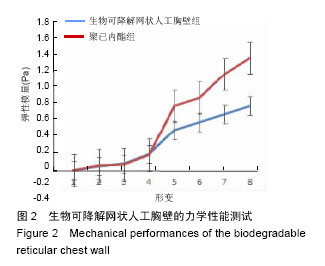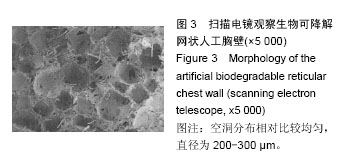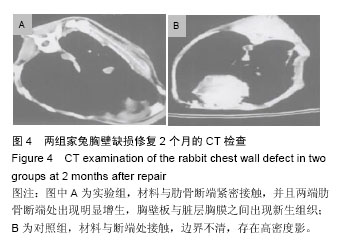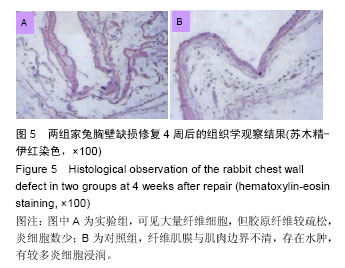| [1] Ni Wu IV, Lin Y, Li T, et al. Clinical application of Polyester cloth plus bone cement composite in repair of large chest wall defect after tumor resection. Journal of Guangdong Medical Coll.2009;27(1): 56-57.
[2] 匡毅,蒋又新,李福沛,等.带蒂背阔肌肌皮瓣修复腹壁巨大缺损的临床疗效分析[J].第三军医大学学报, 2013, 35(15): 1643-1645.
[3] 黄国金,张王山,谢鹏,等.人工补片胸壁重建治疗胸壁巨大缺损[J].中国修复重建外科杂志,2011,25(7):895-896.
[4] Zhang LJ,Wang WP,Li WY,et al.A new alternative for bony chest wall reconstruction using biomaterial artificial rib and pleura: animal experiment and clinical application.Eur J Cardiothorac Surg. 2011;40(4): 939-947.
[5] 彭秀凡,乔贵宾,唐勇,等.猪源人工骨进行胸壁缺损修复重建的疗效观察[J].中华临床医师杂志:电子版, 2012,6(13): 3595-3598.
[6] Stangenberg L,Schaefer DJ,Buettner O,et al. Differentiation of osteo-blasts in three-dimensional culture in processed cancellous bone ma-trix: quantitative analysis of gene expression based onreal-time reverse transcription-polymerase chain reaction.Tissue Eng.2005;11:855-864.
[7] 杨林林,戴景兴,崔甜甜,等.猪源性异种骨支架材料的生物相容性[J].中国组织工程研究与临床康复, 2007,11(44): 8821-8825.
[8] 陈学英,李宝兴,李靖,等.异种骨移植材料制备及其骨诱导活性实验研究[J].中国修复重建外科杂志, 2009,23(3): 362-365.
[9] 张兰军,李伟阳,苏晓东,等.生物材料人工胸壁重建巨大胸壁缺损(附5例报告)[J].第四军医大学学报, 2007,28(24): 2259-2262.
[10] Nishimoto S,Fukuda K,Kawai K,et al.Supplementation of bone marrow aspirate-derived platelet-rich plasma for treating radiation-induced ulcer after cardiac fluoroscopic procedures: A preliminary report.Indian J Plast Surg.2012;45(1):109-114.
[11] Maaloe N,Bonde C,Laursen I,et al.Mannan-binding lectin and healing of a radiation -induced chronic ulcer --a case report on mannan-binding lectin replacement therapy.J Plast Reconstr Aesthet Surg. 2011;64(6): e146-e148.
[12] Koch H,Tomaselli F,Pierer G,et al. Thoracic wall reconstruction using both portions of the latissimus dorsi previously divided in the course of posterolateral thoracotomy.Eur J Cardiothorac Surg. 2002;21(5): 874-878.
[13] 赖文,孙传伟,李勇,等.腹腔镜大网膜轴型瓣转移修复乳腺癌术后胸部放射性溃疡[J].现代医院, 2013,13(7):30-33.
[14] 陈克能,Yu PeiRong.外科多专业合作胸壁切除与重建术在乳腺癌侵犯胸壁患者治疗中的地位[J].中华肿瘤杂志, 2006,28(11):856-859.
[15] Deo SV,Purkayastha J,Shukla NK,et al.Myocutaneous versus thoraco-abdominal flap cover for soft tissue defects following surgery for locally advanced and recurrent breast cancer.J Surg Oncol. 2003;83(1): 31-35.
[16] Rocco G,Scognamiglio F,Fazioli F,et al.V-Y latissimus dorsi flap for coverage of anterior chest wall defects after resection of recurrent chest wall chondrosarcoma.J Thorac Cardiovasc Surg. 2009; 138(5):1242-1243.
[17] 张晨芳,田浩,张玉新.邻近扩张皮瓣对局部晚期乳腺癌术中胸壁软组织缺损的修复[J].中国普通外科杂志, 2009, 18(11):1229-1230.
[18] 宋君涛,郭志坤.骨科修复重建中医用钛网的应用[J].中国组织工程研究,2013,17(12):2233-2240.
[19] 宁漱岩,乔伟松,刘建国.金属钛网支撑颗粒骨植骨处理人工全髋关节翻修中的髋臼骨缺损[J].中国组织工程研究与临床康复,2009,13(43):8475-8479.
[20] Secchi AG,Grigoriou V,Shapiro IM,et al.RGDS peptides immobilized on titanium alloy stimulate bone cell attachment,differentiation and confer resistance to apoptosis.J Biomed Mater Res A.2007;83(3):577-584.
[21] 张晓东,杨维东,宋九余,等.钛网加强的BMSC/松质骨基质修复下颌骨缺损的实验研究[J].临床口腔医学杂志, 2003,19(10):582-584.
[22] 殷渠东,顾三军,孙振中,等.钛网打压植骨重建四肢长骨节段骨缺损[J].中国组织工程研究, 2012,16(48):9096-9100.
[23] Teixeira CR,Rahal SC,Volpi RS,et al.Tibial segmental bone defect treated with bone plate and cage filled with either xenogeneic composite or autologous cortical bone graft.An experimental study in sheep.Vet Comp Orthop Traumatol.2007;20(4):269-276.
[24] Wu X,Liu X,Wei J,et al.19.Nano-TiO(2)/PEEK bioactive composite as a bone substitute material: in vitro and in vivo studies.Int J Nanomedicine.2012;7:1215-1225.
[25] 张云坤,郁忠杰,贾晓钧,等.钛网植骨修复四肢长骨干骨缺损的实验研究[J].江苏大学学报(医学版), 2006,16(4):288-290.
[26] 张开放,闫宏伟,刘凯,等.仿生骨植入钛网管固定修复兔骨缺损[J].西安交通大学学报(医学版),2007,28(1):89-92.
[27] 李国臣,王林,桑宏勋,等.可控微结构电子束熔化成形钛合金支架作为成骨细胞载体修复兔骨缺损的研究[J].中华创伤骨科杂志,2010,12(6):557-561.
[28] 周宁峰,王金武,刘昌胜,等.负载rhBMP-2的CPC活性人工骨修复骨缺损的临床应用[J].中国修复重建外科杂志, 2009,23(3):257-259.
[29] 刘高峰,李保田,谢家声,等.应用钛网修复大块胸壁缺损(附2例报告)[J].实用医药杂志,2009,9(9):29.
[30] 丘平,王正,林少霖,等.胸骨切除后钛网胸廓重建治疗胸骨肿瘤的临床研究[J].新医学,2010,41(12):789-791.
[31] 刘顺振,侯玉东.骨组织工程支架材料的研究进展及临床应用[J].中国组织工程研究与临床康复, 2011,15(42): 7911-7914.
[32] Cruz DM,Gomes M,Reis RL,et al.Differentiation of mesenchymal stem cells in chitosan scaffold with double micro and macroporosity.J Biomed Mater Res A.2010;95A(4):1182-1193.
[33] 刘雷,李起鸿,唐康来,等.异种脱蛋白组织工程骨支架材料的制备及理化特性的研究[J].第三军医大学学报, 2007,29(1):12-14.
[34] 陈学英,李宝兴,李靖,等.异种骨移植材料制备及其骨诱导活性实验研究[J].中国修复重建外科杂志, 2009,23(3): 362-365.
[35] Song JH,Ma SQ,Wang KZ,et al.Preparation and characterization of poly(lactic-co-glycolic acid) microspheres for controlled release of osteogenic growth peptide.Zhongguo Zuzhi Gongcheng Yanjiu yu Linchuang Kangfu.2007;11(4):8987-8991.
[36] 周立伟,魏世成,李玉宝,等.纳米羟基磷灰石/聚酰胺66复合人工骨修复颅骨缺损的动物实验研究[J].口腔医学,2009, 29(11):561-563.
[37] 段宏,张开伟,闵理,等.纳米羟基磷灰石聚酰胺66骨填充材料修复肢体良性肿瘤术后骨缺损的疗效分析[J].中国骨与关节外科,2009,2(5):341-346. |
.jpg)




.jpg)
.jpg)
.jpg)